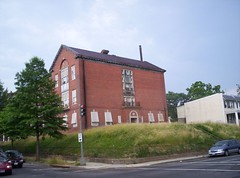No further public use...
Yesterday there was a hearing before the City Council Committee on Government Operations about the "disposition of surplus property," said surplus being four former DCPS school sites in Wards 1, 5, and 8. This was discussed yesterday on the columbia_heights email list, and I have written about it from time to time. The People's Property Campaign spearheaded by EmpowerDC has been the most active on this issue, and members of the campaign testified yesterday.
______________________________________
People's Property Campaign talking points
Our Concerns
· We are concerned about the continued sale, transfer and give-away of public assets including vacant public schools, parks and green space, and all types of property owned and maintained by District residents and taxpayers, and managed by the District of Columbia government.
· We believe that public property should be used for public benefit, but the District’s current policies do not correspond with this idea. The closing of the Randall School Shelter last year despite weeks of protests exemplifies the District’s trend to abandon public property, rather than to reuse, redevelop, and revitalize.
The People’s Property Campaign is demanding that public property be used for community needs such as:
*Recreation for all ages (teens & seniors!) * Community green/play space * Shelter * Affordable housing * Health Services * AND OTHER NEEDS LONG IDENTIFIED BY OUR COMMUNITIES!
Our Proposal:
1. Initiate an immediate moratorium on the disposition of public property.
2. Establish an inventory of all public property – according to the DC Code the Office of Property Management is responsible for creating an inventory by March 2006. We need to make sure this happens.
3. Institute a new policy to ensure that abandoned public property is re-used to serve community needs.
a. Support the introduction of legislation to require public property, when no longer used by the city, to be leased, not sold.
b. Consider priorities listed in the City-Wide Strategic Plan, Strategic Neighborhood Action Plans (SNAPs), Executive Summary from the Citizen Summit III, and other studies or surveys published within the past five years when re-developing abandoned public spaces.
 Old Bruce School in Columbia Heights.
Old Bruce School in Columbia Heights.For a building to be declared surplus, the city government has to make a determination that there is "no further public use."But there is no systematic process to determine this, and we don't really have neighborhood plans. (To my way of thinking, the "Strategic Neighborhood Action Plans" aren't neighborhood plans, they are more a collection of priorities at a particular point in time.)
For real neighborhood plans, those for the Aycock Neighborhood in Greensboro are pretty good: Strategic Plan For the Aycock Neighborhood and the Aycock Traditional Neighborhood Plan Charette book. Plus there are many other resources I have listed before, such as the Neighborhood Planning website, or the Neighborhood Revitalization Planning program in Minneapolis. Other cities, such as Seattle, also have very engaged neighborhood-centric planning operations.
Some of the points made by an ANC1A Commissioner on the listserv:
ANC1A had, at the 2000 count of the US Census, approximately 22,000 residents. We all know that residential -- density has increased since then and continues to increase at a fast pace. In addition:
--ANC1A has no DC community day care programs
--ANC1A has no library (in fact, though there are twenty-seven libraries city-wide, there is only one library in Ward One)
--ANC1A has one recreation center (there are five in all of Ward One, some other wards have eleven or twelve)
--Ward One has the least city park acreage of any other Ward;
are similar to those made wrt a couple pieces of property in the H St. neighborhood, and I specifically mentioned the idea of arts incubation to complement the developing arts and entertainment area on H Street, as well as my idea of creating an "arts-oriented cluster schools" setup in the neighborhood (modelled after the Capitol Hill Cluster Schools) which would also complement the arts focus on the eastern end of H St.
But once a building is put up for sale, non-market uses have an almost impossible time competing, and the number of points allocated to community uses and issues in an RFP tend to number no more than 15 of 100. Plus nonprofits tend to not have money and a development team waiting in the wings for properties to come up for sale...
I have mentioned on this list in the past an article from the Boston Globe that I think provides an interesting framework relevant to these questions. It's mentioned in this blog entry "Speaking of City Revitalization...assets, assets, assets". I have edited them from the original article to be a bit more relevant to our issue:
-- Requiring that any exercise of sale of public assets for economic development have a primarily public purpose rather than a merely incidental one.
-- Requiring the government to demonstrate the public benefit through a full-scale financial analysis that could be challenged in court.
-- Requiring that sale of public assets not be used for a solely fiscal purpose and that it instead must be part of a comprehensive land use plan.
-- Requiring that the affected neighborhood have adequate participation in the planning process, a right that would be backed up by state-provided technical assistance upon the neighborhood's request.
The "property portfolio" of the District Government ought to be considered public assets held in trust for the residents of the District of Columbia, rather than some "assets" ready to be disposed of. We aren't making new land, so what the city has today is a precious resource that needs to be managed in such a way as to assist various endeavors such as stabilizing and enhancing neighborhoods, creating a "city of learning," providing affordable housing resources, etc.
Without an open process to look at the city property portfolio in such a manner, citizens are being dis-served.
Index Keywords: public-assets



0 Comments:
Post a Comment
<< Home